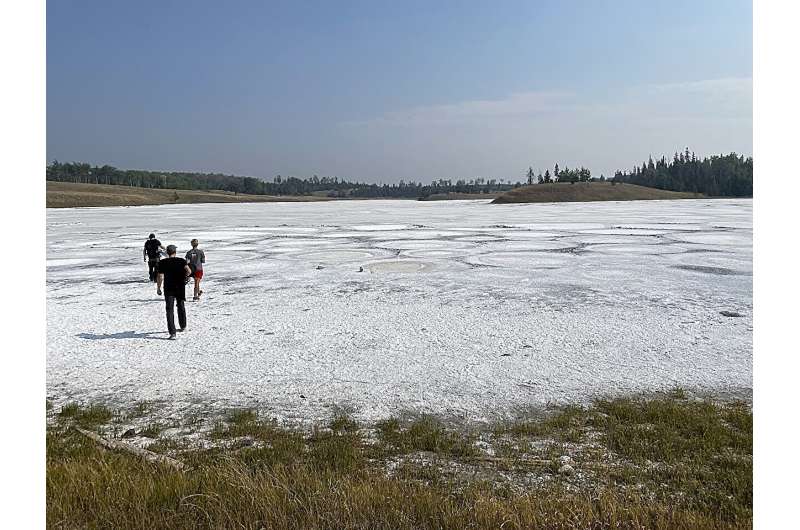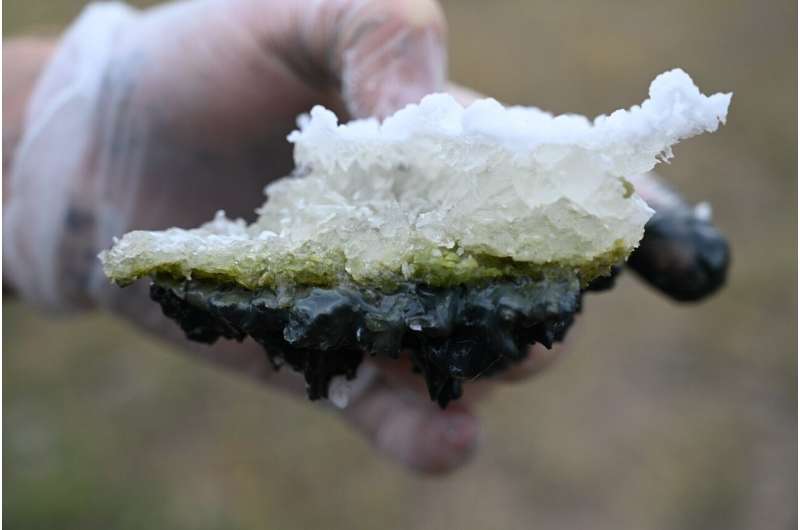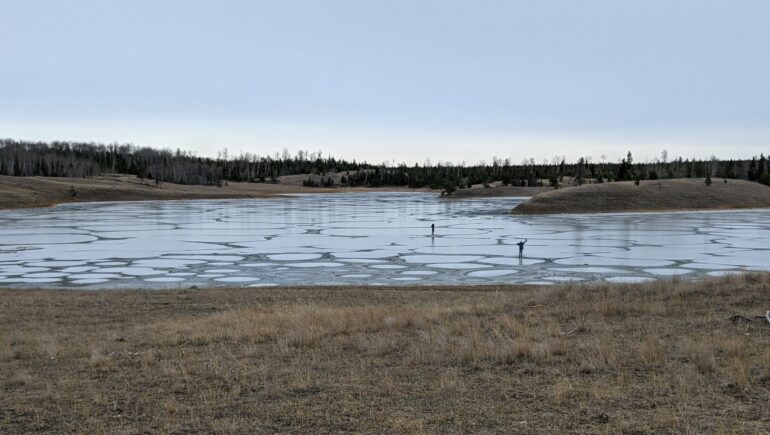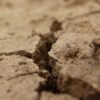Charles Darwin proposed that life could have emerged in a “warm little pond” with the right cocktail of chemicals and energy. A study from the University of Washington, published this month in Communications Earth & Environment, reports that a shallow “soda lake” in western Canada shows promise for matching those requirements. The findings provide new support that life could have emerged from lakes on the early Earth, roughly 4 billion years ago.
Scientists have known that under the right conditions, the complex molecules of life can emerge spontaneously. As recently fictionalized in the blockbuster hit “Lessons in Chemistry,” biological molecules can be coaxed to form from inorganic molecules. In fact, long after the real-life 1950s-era discovery made amino acids, the building blocks of proteins, more recent work has made the building blocks of RNA. But this next step requires extremely high phosphate concentrations.
Phosphate forms the “backbone” of RNA and DNA and is also a key component of cell membranes. The concentrations of phosphate required to form these biomolecules in the lab are hundreds to one million times higher than the levels normally found in rivers, lakes or in the ocean. This has been called the “phosphate problem” for the emergence of life—a problem that soda lakes may have solved.
“I think these soda lakes provide an answer to the phosphate problem,” said senior author David Catling, a UW professor of Earth and space sciences. “Our answer is hopeful: This environment should occur on the early Earth, and probably on other planets, because it’s just a natural outcome of the way that planetary surfaces are made and how water chemistry works.”
Soda lakes get their name from having high levels of dissolved sodium and carbonate, similar to dissolved baking soda. This occurs from the reactions between water and volcanic rocks beneath. Soda lakes can also have high levels of dissolved phosphate.
Previous UW research in 2019 found that chemical conditions for life to emerge could theoretically occur in soda lakes. The researchers combined chemical models with laboratory experiments to show that natural processes can theoretically concentrate phosphate in these lakes to levels up to 1 million times higher than in typical waters.

Members of the research team walk across the surface of Last Chance Lake in September 2022. At the end of the summer, the water has almost all evaporated, leaving a salty crust on the surface. But water persists below in pockets and hollows, and soft sediments sit beneath, creating a somewhat treacherous crème brûlée structure to walk on. © Zack Cohen/University of Washington
For the new study, the team set out to study such an environment on Earth. By coincidence, the most promising candidate was within driving distance. Tucked away at the end of a master’s thesis from the 1990s was the highest known natural phosphate level in the scientific literature at Last Chance Lake in inland British Columbia, Canada, about seven hours’ drive from Seattle.
The lake is about one foot deep and has murky water with fluctuating levels. It sits on federal land at the end of a dusty dirt road on the Cariboo Plateau, in British Columbia ranching country. The shallow lake meets the requirements for a soda lake: a lake above volcanic rock (in this case, basalt) combined with a dry, windy atmosphere that evaporates incoming water to keep water levels low and concentrates dissolved compounds within the lake.
Analysis published in the new paper suggests soda lakes are a strong candidate for the emergence of life on Earth. They also could be a candidate for life on other planets.
“We studied a natural environment that should be common throughout the solar system. Volcanic rocks are prevalent on the surfaces of planets, so this same water chemistry could have occurred not just on early Earth, but also on early Mars and early Venus, if liquid water was present,” said lead author Sebastian Haas, a UW postdoctoral researcher in Earth and space sciences.
The UW team visited Last Chance Lake three times from 2021 to 2022. They collected observations in early winter, when the lake was covered in ice; in early summer, when rain-fed springs and snowmelt-fed streams put water at its highest; and in late summer when the lake had almost completely dried up.
“You have this seemingly dry salt flat, but there are nooks and crannies. And between the salt and the sediment there are little pockets of water that are really high in dissolved phosphate,” Haas said. “What we wanted to understand was why and when could this happen on the ancient Earth, in order to provide a cradle for the origin of life.”

Sebastian Haas holds a piece of the salt crust from Last Chance Lake with green algae in the middle and black sediment at the bottom. © David Catling/University of Washington
On all three visits the team collected samples of water, lake sediment and salt crust to understand the lake’s chemistry.
In most lakes the dissolved phosphate quickly combines with calcium to form calcium phosphate, the insoluble material that makes up our tooth enamel. This removes phosphate from the water. But in Last Chance Lake, calcium combines with plentiful carbonate as well as magnesium to form dolomite, the same mineral that forms picturesque mountain ranges. This reaction was predicted by the previous modeling work and confirmed when dolomite was plentiful in Last Chance Lake’s sediments. When calcium turns into dolomite and does not remain in the water, the phosphate lacks a bonding partner—and so its concentration rises.
“This study adds to growing evidence that evaporative soda lakes are environments meeting the requirements for origin-of-life chemistry by accumulating key ingredients at high concentrations,” Catling said.
The study also compared Last Chance Lake with Goodenough Lake, a roughly three-foot-deep lake with clearer water and different chemistry just a two-minute walk away, to learn what makes Last Chance Lake unique. The researchers wondered why life, present in all modern lakes at some level, was not using up the phosphate in Last Chance Lake.
Goodenough Lake has mats of cyanobacteria that extract or “fix” nitrogen gas from the air. Cyanobacteria, like all other lifeforms, also require phosphate—and its growing population consumes some of that lake water’s phosphate supply. But Last Chance Lake is so salty that it inhibits living things that do the energy-intensive work of fixing atmospheric nitrogen. Last Chance Lake harbors some algae but has insufficient available nitrogen to host more life, allowing phosphate to accumulate. This also makes it a better analog for a lifeless Earth.
“These new findings will help inform origin-of-life researchers who are either replicating these reactions in the lab or are looking for potentially habitable environments on other planets,” Catling said.
More information:
Sebastian Haas et al, Biogeochemical explanations for the world’s most phosphate-rich lake, an origin-of-life analog, Communications Earth & Environment (2024). DOI: 10.1038/s43247-023-01192-8
Provided by
University of Washington
Citation:
Shallow soda lakes show promise as cradles of life on Earth (2024, January 22)



